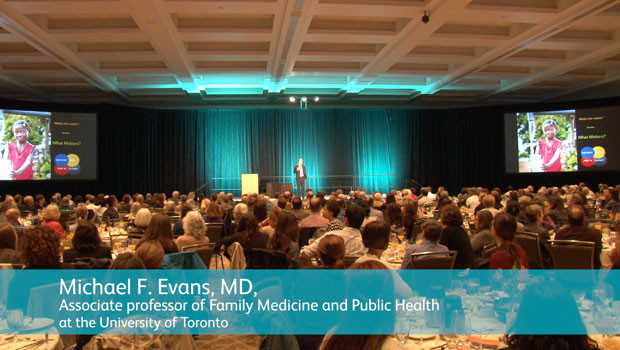6 great ideas from Dr. Mike Evans’ Birnbaum lecture

How we’re using email, smartphones, YouTube, and other digital media to inspire healthier ways
Digital technology is quickly changing health and health care, giving us countless ways to take better care of ourselves and our families. Dr. Mike Evans, the speaker at Group Health’s June 3, 2015 Birnbaum Endowed Lecture at the Washington State Convention Center, presented a host of thought-provoking ideas for using new technologies to inspire healthy habits. Here are six of the best moments from his talk. (Click on the video titles below to view) You can also watch the entire presentation.
1. Embed stories in the relationships of care
(YouTube, 1:56)
Because two-thirds of all health care happens at home, Dr. Evans said “the biggest health care workforce is the public—friend to friend, mother to daughter, and so on.” That’s why his Health Media Lab at the University of Toronto creates entertaining, video-based content that people want to share on Facebook and other social media. “Stories trump data,” he said, and we can inspire others to make healthy choices when we “embed stories in the relationships of care.”
2. Use email to make doctor-patient relationships better
(YouTube, 3:03)
What happened when an 85-year-old patient told Dr. Evans she preferred to connect with him via the Internet rather than office visits? It inspired him to launch his email clinic. With online visits, “medicine changes and it doesn’t,” he explained. “The relationship is still paramount.”
3. Use smartphones to nudge people toward healthy habits
(YouTube, 2:35)
Dr. Evans sees a future where apps on your smartphone or smart watch can be your health “nudge.” If you’re got hypertension, for example, the app could take your blood pressure, send the data to your health team, track your medication use, show you a helpful video, and send you reminders to eat healthy and take your pills. “The point is, health is about our daily habits—not seeing me four times a year,” he said.
4. Use social media for impact on public health policy
(YouTube, 1:57)
Dr. Evans learned the power of YouTube during Canada’s recent debate over physician-assisted death. After his team’s video interview on the subject with a terminally ill doctor garnered 80,000 YouTube views, the issue was suddenly “on the front table of the Health Ministry’s meeting.”
5. Move quickly and don’t be afraid to fail
(YouTube, 3:32)
While other industries excel at learning from failure, many in health care still have a hard time talking about mistakes. Dr. Evans encouraged embracing problems as learning opportunities because “the signposts to success and failure point in the same direction.” He also touted shorter timeframes for experiments, so that organizations can learn from mistakes and make adjustments more quickly. The idea is to advance rapidly in this sequence: “Failure, base hit, homerun,” he said.
6. Be a curator
(YouTube, 11:46)
“Not everybody has a media lab but all of us can be curators,” said Dr. Evans. When we find great content on the Web, use social media to point the way for friends, relatives, patients, and others. Dr. Evans shared an extraordinary video he helped produce about a man who knew he would probably die within six weeks. “This guy is incredible at reframing end-of-life,” Dr. Evans said. “I send this to my patients who are at this stage.”
About 400 people attended Dr. Evans’s talk, sponsored by Group Health Research Institute and the Group Health Foundation. This was the 16th annual Birnbaum Endowed Lecture, honoring Group Health co-founders Hilde and Bill Birnbaum’s long-term commitment to the organization and their passion for research that improves patient care.
by Joan DeClaire


